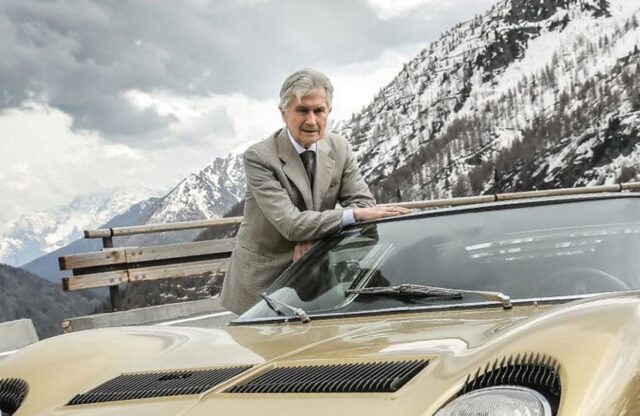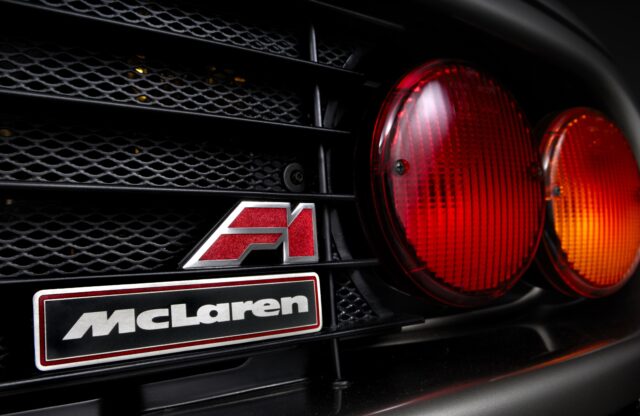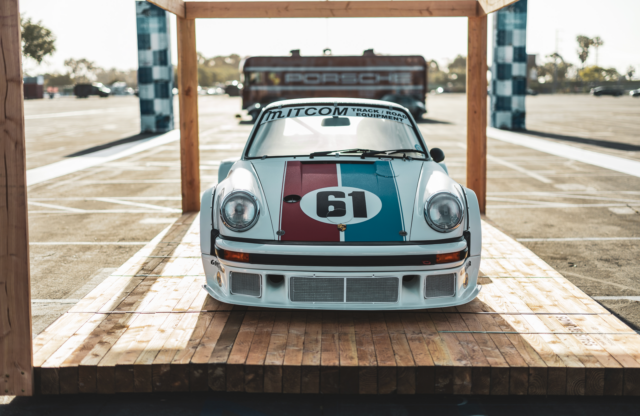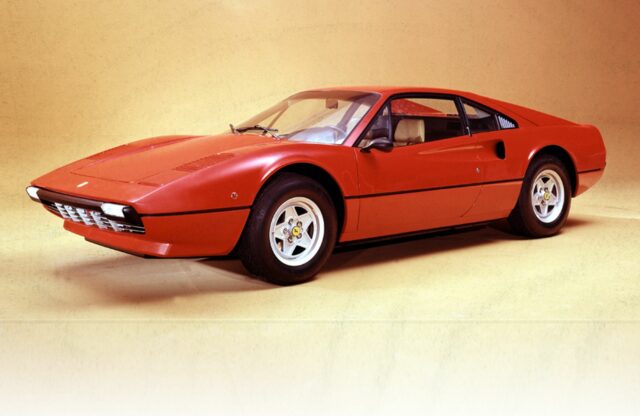WORDS: WAYNE BATTY | PHOTOS: STELLANTIS, LAMBORGHINI, FERRARI
Master car designer Marcello Gandini has a back catalogue full of automotive treasure. We pick ten of our all-time favourites.
10 – FIAT X1/9
As with so many of Marcello Gandini’s production car designs, you don’t have to look too far in the past to find a wild concept that came first. In this case, it’s his 1969 Autobianchi Runabout, which so distinctly informs the design of the 1972 Fiat X1/9. From the general wedge shape, long flat arrow-head bonnet, large front overhang and reverse-rake C-pillar that doubles as a rollover hoop, the inspiration is crystal clear. While far more restrained than the concept, the little production mid-engined two-seater Fiat was blessed with a few tricks of its own. These included pop-up headlights, a removable hard-top that could be stowed beneath the bonnet, plus front and rear storage areas.
Sweet, balanced handling came courtesy of MacPherson-strut suspension all round, responsive rack-and-pinion steering and pretty even weight distribution. Clever packaging that positioned the fuel tank and spare wheel ahead of the engine, behind the seats, played a role here. Motivation, to the tune of 73bhp, was provided by the Fiat 128 saloon’s then brand-new Lampredi-designed single-cam 1.3-litre inline-four, while disc brakes all round kept things easily in check.
Over 16 years in production (first by Fiat and then, from 1982 onwards, by Bertone), around 160,000 were built in total. The majority of those were shipped directly to US customers; being the first Fiat designed to meet North American safety regulations from the outset sure helped its case. Sadly, the number still in use has decreased markedly; probably an opportune moment to mention that they have an uncanny ability to rust. Seeing an X1/9 on the road today is an increasingly rare treat.
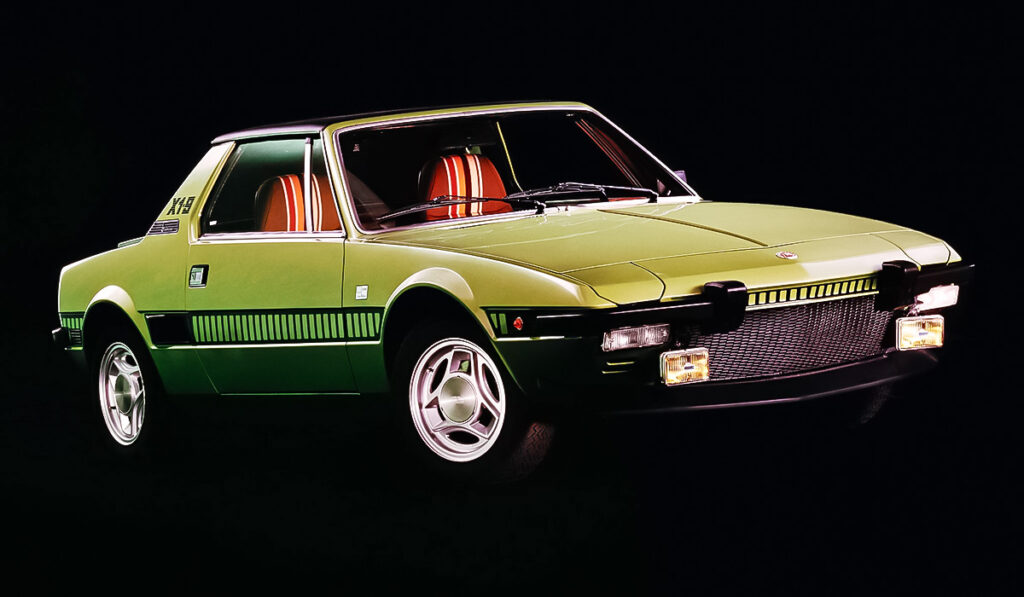
9 – FERRARI DINO 308 GT4
Ferrari says the reason the 1973 308 GT4 was its first new model not to be styled by Pininfarina in more than two decades was down to Enzo’s appreciation for the angular, slim and futuristic sports cars Gandini had been delivering as chief designer for Bertone at the time. One of those cars was the Lamborghini Urraco, a sharp-suited sports machine with a 2.5-litre V8 engine mounted behind a second row of seats. If Ferrari’s brief to Bertone was to aim for the Urraco, Marcello hit the bullseye. As such, the Dino 308 GT4 broke the usual Ferrari mould in several ways: it was both the marque’s first mid-engined 2+2 and its first production V8-powered road car. It was also the first model from Maranello to break from the curvaceous style of the past and embrace the new wedge era.
That traditional Ferrari buyers were not all as welcoming is probably fair comment. Although fully fledged Ferraris in every way, the launch cars were badged solely as Dinos, as was Enzo’s wont for models sporting fewer than 12 cylinders. From 1975, though, slow US sales prompted a change that saw all subsequent cars leave the factory wearing the famous black-on-yellow Prancing Horse logo. A tax-friendly 2.0-litre V8 was added for the Italian market. In the end, however, total sales of around 3660 weren’t quite enough to convince Ferrari that its Bertone experiment was a successful one. As a result, Bertone’s attempt to woo them with the even more angular 1976 Rainbow concept would fall flat, meaning the 308 GT4 would be the first and last production Ferrari that Gandini would ever create.
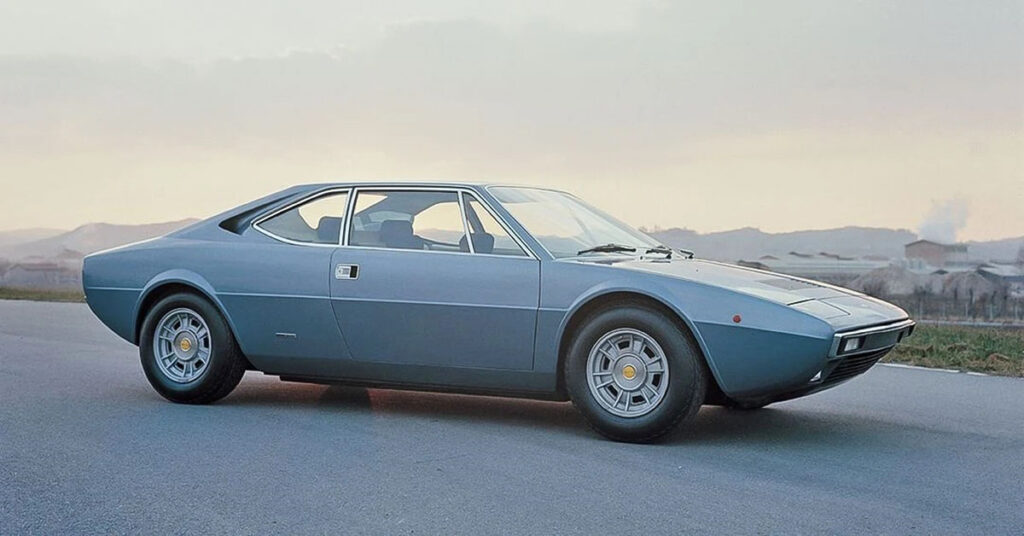
8 – CITROËN BX
Most creative people know it’s a good idea to hang onto a good idea. When Turkish carmaker Otosan declined to replace its aging Anadol models with Reliant’s 1977 Gandini-designed FW11 proposal, the concept’s central themes – origami lines, squared-off arches and substantial, vent-detailed C-pillars – were not abandoned by Bertone. Although Gandini’s edgy style was probably a little too progressive for the conservative Swedes when reimagined as the 1979 Volvo Tundra, Citroën would prove a far more willing suitor. The French brand had, after all, made avant-garde its calling card.
Codenamed XB, the project to design and develop a modern five-door hatchback to replace the GS was started in 1978, around two years after Peugeot had taken a majority controlling stake in the then-ailing company. It culminated in the 1982 reveal beneath the Eiffel Tower of the production BX. The newly formed PSA Group probably would not have guessed that the BX would go on to almost single-handedly justify Peugeot’s investment, with sales of around 2.3 million cars over its 12-year lifespan.
With money in the development kitty once more, the BX rode on an all-new platform and used a weight-saving mix of galvanised steel (body and doors) and plastic composites for the bonnet, tailgate and bumpers. For potential buyers, comfort and roadholding were expected from the hydropneumatic suspension system, but the sprightly performance on offer from the range of Peugeot petrol inline-fours was a surprise. While these aspects, combined with lightness, economy, practicality and inherent reliability were key elements of its sales success, there can be no doubt that Gandini’s measured refinement of his late-1970s style ideas, while seemingly out of step with the looming Sierra-led organic zeitgeist, still resonated with many.
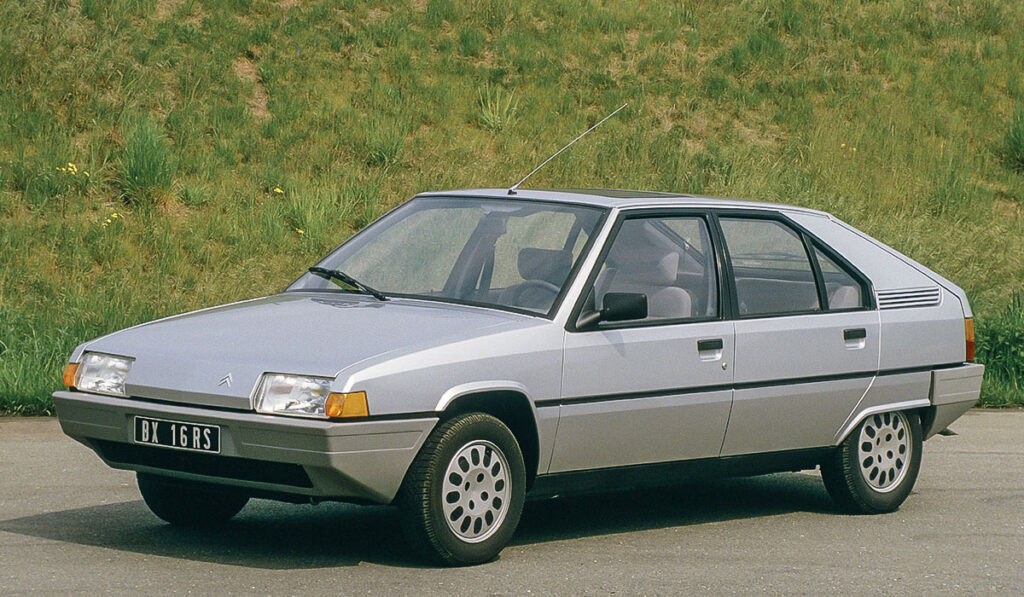
7 – LANCIA STRATOS ZERO
From simple exercises in creativity to exploring design-language evolution and the trialling of advanced ideas, concept cars can serve many purposes. More often than not they’re harbingers of forthcoming production models, and sometimes they’re just flights of fantasy. On the rare occasion, though, they can be both. That is certainly the case with the 1970 Turin Auto Show Stratos Zero, which, as a low-slung, mid-engined sports car built on the chassis of a Lancia Fulvia HF1600 rally car, presaged the production Stratos rally and road machines.
However, it did so while pushing the bounds of visual credulity way beyond the stratosphere. Seeing it out on the road, mixing it with 1970s traffic, must have been like witnessing an alien invasion. And it probably still is. Unfeasibly low at just 84cm tall, and featuring a retractable steering wheel and futuristic tablet-like faux-digital instrumentation, its integrated chocolate-block-patterned bucket recliners could only be accessed via the flip-up front windscreen door. With a side-hinged, triangular-louvred engine cover, ultra-slim headlights built into an ultra-thin nose, and 84 tail-light bulbs on its bluff rump, the Zero had ‘mega flight of fantasy’ written all over its copper-coloured bodywork. As far as outrageous concept cars go, Bertone and Gandini’s Stratos Zero is among the finest ever conceived.
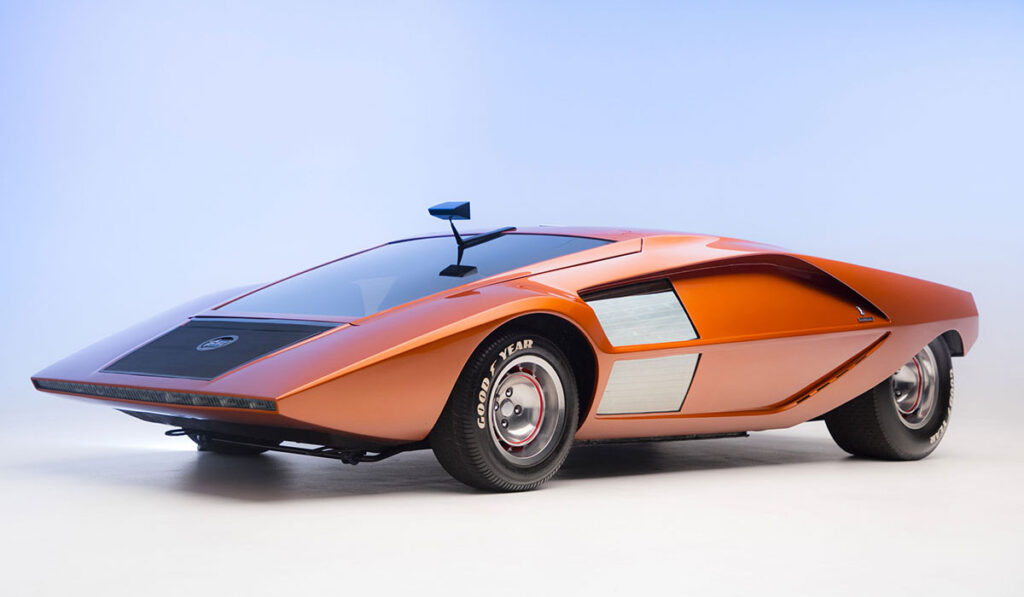
6 – ALFA ROMEO MONTREAL
Attendees of the 1967 Montreal Expo were treated to identical Alfa Romeo concept coupés positioned between two mirrors that reflected their image infinitely. Designed and built by Carrozzeria Bertone on an Alfa Romeo Giulia Sprint GT chassis in less than nine months, these dream machines would not go unnamed for long. Gandini’s exquisite Montreal concepts, as they were quickly christened by show-goers, drew subtle inspiration from his impressive Lamborghini Miura and Bertone’s 1964 Alfa Romeo Canguro. An overwhelmingly positive reaction from observers convinced Alfa Romeo to put the car into full-scale production.
When the first series prototype appeared at the Geneva Motor Show in 1970, the concept car’s distinctive features – Kamm tail, slatted headlight covers, B-pillar vent slots and beautifully balanced proportions, although tweaked, were all pleasingly still in place. However, the addition of a NACA duct to the bonnet pointed to a major mechanical change below. The concept’s 1.6-litre four and Alfa five-speed gearbox had been ditched in favour of a 2.6-litre fuel-injected V8 developed by the company’s Autodelta racing department along with a beefier ZF five-speed unit. Good for 200bhp and 173lb ft of torque, the car, now officially called Montreal, could top 135mph and hit 60mph in less than eight seconds. Fast for its time, beautiful for all time.
While it was a good cruiser, sporty drivers found it less rewarding, with nose-heavy cornering and brakes that lacked sufficient bite. Ultimately, though, it was the thirsty V8 and the oil crisis that killed it off, but not before around 3900 found homes. Ironically, none were sold in Canada or the US, because Alfa Romeo chose not to homologate the Montreal for the North American market.

5 – LAMBORGHINI MARZAL
How to follow up on the 1966 Geneva show-stopping Miura? This was the question Nuccio Bertone and his crack young designer Gandini must have asked themselves in advance of the 1967 edition of the great Geneva Salon. The answer was a shocker, but in the very best way. Where the Miura was all sweeping lines and voluptuous curves – the absolute pinnacle of a design idiom that had shaped sports cars for decades – the Marzal was from another dimension. Its sharp lines and flattened surfaces heralded something altogether new. These alone would have had jaws dropping, but here was a mid-engined four-seater with gullwing doors made almost entirely from glass and an interior upholstered in a silver material that channelled the Apollo space programme.
The futuristic theme didn’t stop there. As if to emphasise the new geometrical design language, Gandini weaved a hexagon motif into various aspects of the interior – the dashboard, main instruments and steering wheel. He repeated the pattern on the rear window louvre, creating yet another highly distinctive design feature. With all the honeycomb detailing easily on view courtesy of a large glass roof and those fully transparent doors, he had managed to ‘bring the outside in’, a phrase that would only become part of car design lexicon decades later. The Marzal was so influential that not only did it directly inform the exterior design of the 1968 Lamborghini Espada but, perhaps more importantly, it inspired many of the incredible concept cars that emerged in the decade immediately following its debut.
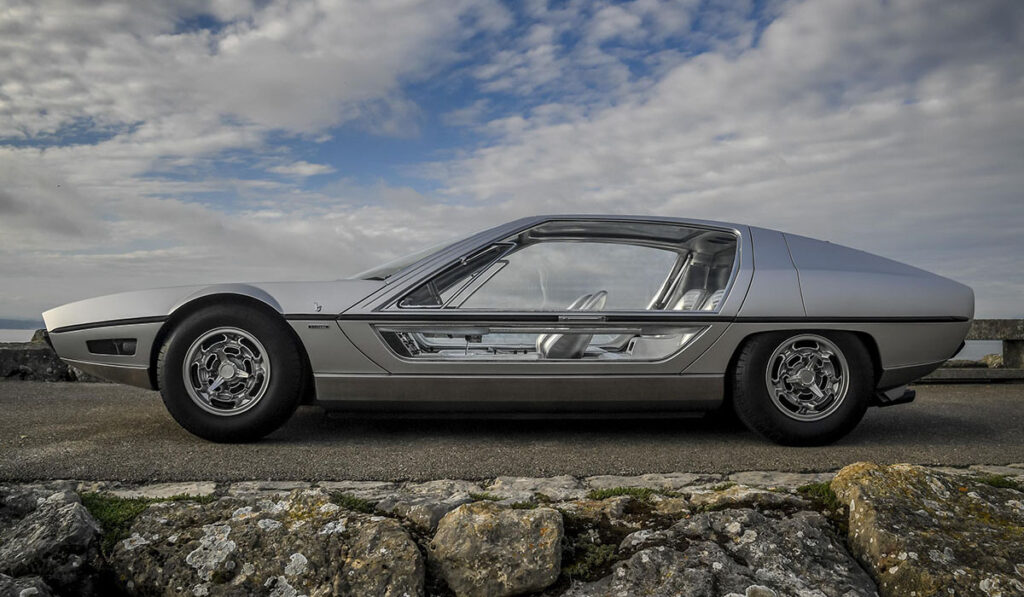
4 – ALFA ROMEO CARABO
Emboldened by the positive reception of his Marzal concept, Gandini doubled down on his new wedge style and then cranked up the creativity. The resulting Carabo went beyond jaw-dropping, it was a visual sensation. Based on the mechanics of the 33 Stradale, a car endowed with levels of conventional beauty very few, if any, have ever matched, the Carabo excited eyeballs in a very different way. For starters, the sheer flatness of its profile – with the windscreen angle differing only fractionally from that of the extremely low-slung bonnet – was a revelation afforded by the absence of a bulky engine between the front wheels. Gandini says this was also to eliminate the front-end lift experienced in the Miura, reiterating that a stylist sympathetic to the engineer makes for a great designer. The car’s thin wedge-shaped front end and high, truncated tail section would quickly become supercar staples.
Beneath the Carabo’s layered engine cooling slats sat the 33 Stradale’s high-revving, race-engineered, 2.0-litre V8. Rated at 227bhp and 152lb ft, it would have provided serious performance bite, more than enough to scare away any challengers – or should that be predators? Inspired in more ways than one by the brightly coloured carabus auratus, a bewinged but flightless golden ground beetle, the Carabo was painted a bright metallic green with a golden orange strip on its nose. And although it featured wings in the form of innovative and dramatic ‘scissor’ doors, it too was consigned to the ground. But it ‘flew’ in other ways. While the Marzal shook the status quo, the Carabo unleashed styling cues that would define a whole generation of sports- and supercars, from the Countach to the Bugatti EB110 and beyond. It is beyond doubt concept car royalty.
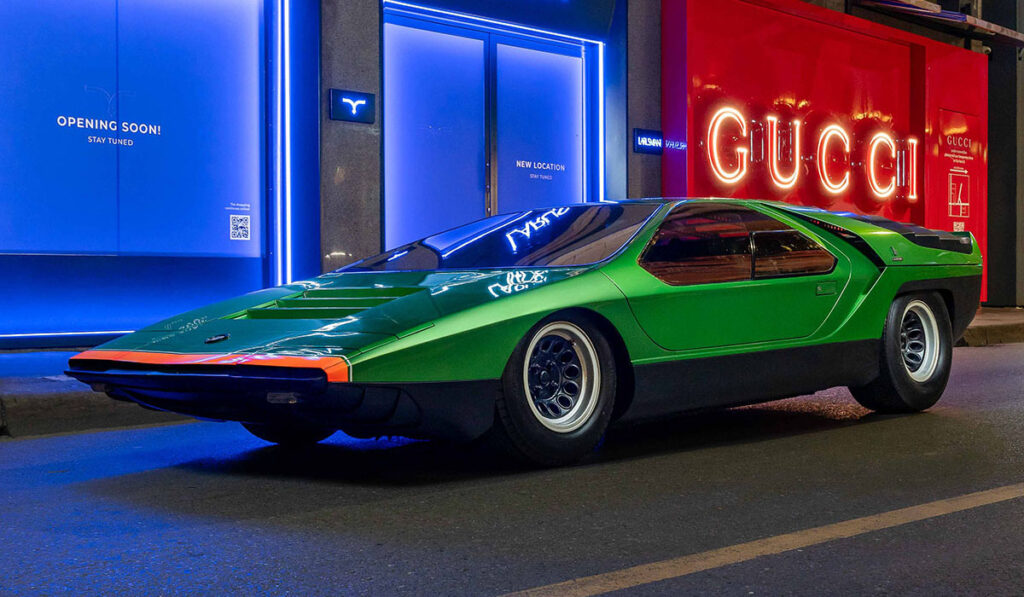
3 – LANCIA STRATOS
Partly inspired by the startling Stratos Zero concept that Bertone had shown the year before, but also driven by the strict requirements of rallying, the 1971 Lancia Stratos HF prototype was another of Gandini’s unforgettable wedge designs. Composed of a razor-sharp flat nose flowing into a severely raked windscreen that appears to wrap around into the doors, pop-up headlights, protruding wheelarches, a vertical rear window, flying buttresses, a truncated tail and oversized circular tail-lights, the Stratos was no shrinking violet. And especially so in the fiery red paintwork of the prototype.
Designed first and foremost to win rallies, it featured a Ferrari-sourced V6, mounted transversally behind the driver, double-wishbone front suspension and MacPherson struts at the rear. The bonnet and engine covers were single-piece, lightweight shells that incorporated the mudguards and provided easy access for inter-stage maintenance and repair. The cabin was tight, with room for two occupants and little else, although the doors did feature cutout compartments for helmet storage.
When the full production version emerged in 1973, it looked much the same bar revised rear lights, the addition of roof and boot spoilers, and Miura-like stepped slats above the engine cover.
To satisfy the FIA’s Group 4 homologation rules, Lancia had to produce 500 cars. Educated guesses suggest it got close to that amount. That sort of exclusivity, allied to WRC rally-winning pedigree, striking good looks and a thrilling driving experience, all mean this little Gandini delight is more desirable than ever.

2 – LAMBORGHNI MIURA
A 27-year-old Marcelo Gandini had been with Carrozzeria Bertone for only a couple of months when the drawings for TP400 arrived from Lamborghini, fresh from a 1965 Turin Motor Show reveal that had generated a surprising amount of interest. TP400 was the internal code given to a newly designed rolling chassis and mechanical package overseen by Giampaolo Dallara and Paolo Stanzani. TP stood for ‘trasversale posteriore’, which referred to the unconventional (mid) rear location and transverse orientation of the 4.0-litre (actually 3929cc) V12 installed in the bare chassis.
Despite the attentions of a multitude of design houses, Ferruccio chose Nuccio to clothe the radical and exciting new chassis. Gandini must have been in heaven; clearly inspired, he set about drawing one of the most beautiful cars of all time. Its body panels, a masterful blend of hard muscle and softer curves, appear to have been shrink-wrapped around the hardpoints. It has immaculate proportions, is simultaneously friendly and aggressive with a good number of intriguing details. It just feels right from every angle.
His sketch proposals for the car that would become known as the Miura, after a Spanish farm famous for breeding particularly fierce bulls, were unanimously and immediately approved. Over the following ten weeks or so, three prototypes were finished in time for the 1966 Geneva Motor Show, where the Miura was instantly and unquestionably deemed ‘star of the show’. Previously little known, Gandini had become an overnight sensation. But this was merely the start, although admittedly a ridiculously strong one, of an extraordinary career.
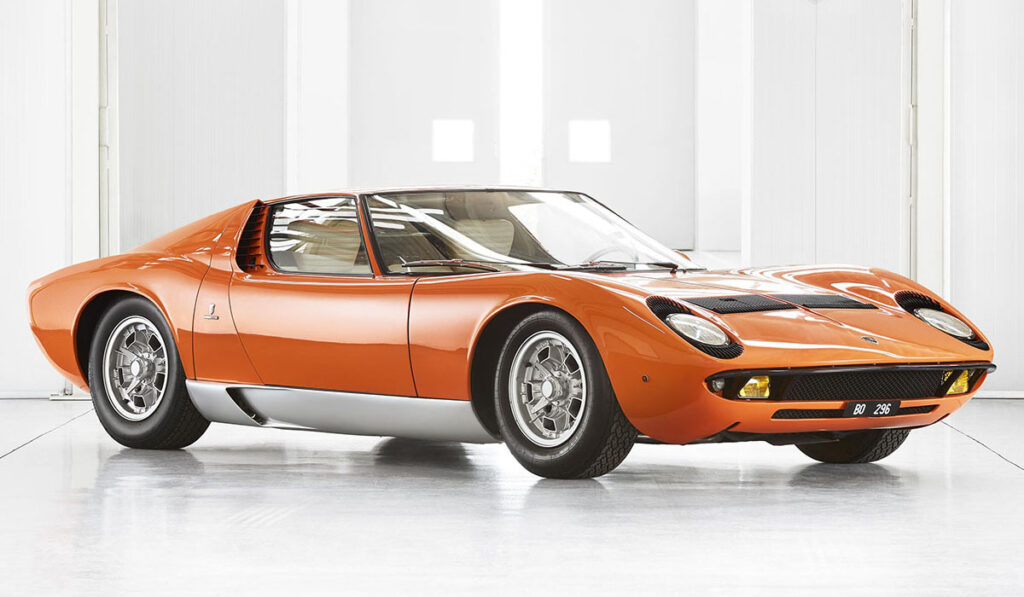
1 – LAMBORGHINI COUNTACH
Even if you’d been following Gandini’s design progression from Miura through Marzal to Carabo and Stratos Zero, and were therefore not as astonished as most by the extreme proportions, brutal sharpness and visual drama of Bertone’s bright yellow 1971 Geneva sensation, you would have been shocked to hear that it was to be the Miura’s production successor. Countach!
Surely just another outrageous concept car from the fertile minds of an ever-fruitful Bertone-Gandini partnership? No, Ferruccio Lamborghini followed through on his announcement, and the Countach LP400 went on sale in 1974 in shockingly similar shape to the yellow UFO that had landed just three years prior. What’s more, it had retained the concept car’s innovative layout of a longitudinally aligned, mid-mounted 3.9-litre V12 with its transmission between the seats. This made the Countach smaller, lighter and faster than the Miura, while simultaneously addressing many of that car’s shortcomings, which included poor front/rear weight distribution, aerodynamic stability and overheating cabin.
That the Countach enjoyed a production run lasting twice as long as the Miura is testament to its impact, not only on the marque but also on the supercar genre itself. Universally popular, the seismic shift it represented in Lamborghini’s design language from sensual to stunning – alongside the manner in which it set the extreme template for every Lamborghini since – makes the Countach our number one Gandini design.

Marcello Gandini was recently honoured at Italy’s Politecnico di Torino. Read more here.
